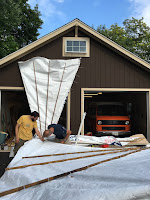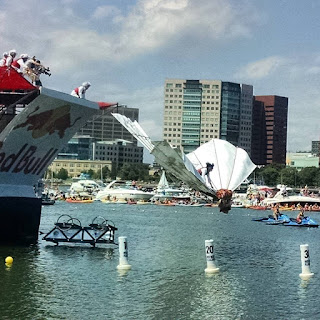Tyvek Aircraft Flies at Boston Red Bull Flugtag Competition
A human powered glider made with Tyvek by Gusdave and the Whiteheads was flown at the Red Bull Flugtag competition from the banks of the Charles River in Boston on August 20, 2016. The Connecticut based five-member team selected Tyvek as the wing and tail material to create the CONNDOR flying machine, and placed 6th out of 29 competitors at the event.
Gusdave and the Whiteheads are aviation enthusiasts with a broad range of talents that include engineering, architecture, and puppet design. They are also historical contrarians, and the flying machine they created pays tribute to and was inspired by Gustave Whitehead, whose aircraft named the Condor is said to have made a successful flight in Connecticut in 1901, 2 years before the Wright Brothers.
To construct this glider, a important consideration was the choice of materials to be used for wing webbing. Gustave's original 1901 machine used silk for the wings; Gusdave and the Whiteheads used Tyvek instead of silk in their CONNDOR plane. They considered silk, cloth, tarps, and sailboat canvas. Jeff Jahnke, a team member and professional architect knew that Tyvek was a very strong material that was light weight and might provide the solution the team was looking for. Jeff was able to obtain a sample of Tyvek and the team conducted tensile tests and concluded it would be strong enough to withstand the forces assumed by the glider as it took flight from a ramp before plunging into the river.
The team said that the Tyvek was easy to cut and manipulate and was used to flesh out two wings, the tail section, and it provided a substrate for signatures and sponsor logos along the walls of the transport cart. The sheets of Tyvek were wrapped along the leading edge of the wings and fuselage and and tail spars made from super strong Calcutta Bamboo posts. Along each wing rib, a duct tape grommet was created that allowed a zip tie to poke through and secure the Tyvek to the post. Additional cabling was necessary to ensure the wings wouldn't fold due to the pressure.
 Dave (Gusdave) Mourad was the CONNDOR pilot and the aircraft placed in the top six in overall score. The flying distance was hampered by strong wind conditions and a limitation on velocity of the pier, but the glider descended smoothly and safely achieving a distance of 36 feet, better than average for the day. The unique rustle and whipping sounds of the vibrating Tyvek enhanced the drama of the glide, and the eventual plummet into the Charles River.
Dave (Gusdave) Mourad was the CONNDOR pilot and the aircraft placed in the top six in overall score. The flying distance was hampered by strong wind conditions and a limitation on velocity of the pier, but the glider descended smoothly and safely achieving a distance of 36 feet, better than average for the day. The unique rustle and whipping sounds of the vibrating Tyvek enhanced the drama of the glide, and the eventual plummet into the Charles River.
Many thanks to Dave Mourad for providing the information and the photos, used with permission. This is a truly unique use for Tyvek, highlighting the some of the key capabilities and physical properties of the Tyvek material in a very creative manner! And while Tyvek Home Wrap, donated by a Connecticut contractor, was used for this project, a white unprinted paper-like hard Tyvek material style would be a good choice for a similar project. Material Concepts provides Tyvek rolls for many unique and innovative projects - contact Material Concepts or via phone: 215-338-6515 or 1-800-372-3366 or buy Tyvek online.
 For more information on topics related to this Tyvek aircraft and the competition, check out these resources:
For more information on topics related to this Tyvek aircraft and the competition, check out these resources:
Gusdave and the Whiteheads are aviation enthusiasts with a broad range of talents that include engineering, architecture, and puppet design. They are also historical contrarians, and the flying machine they created pays tribute to and was inspired by Gustave Whitehead, whose aircraft named the Condor is said to have made a successful flight in Connecticut in 1901, 2 years before the Wright Brothers.
To construct this glider, a important consideration was the choice of materials to be used for wing webbing. Gustave's original 1901 machine used silk for the wings; Gusdave and the Whiteheads used Tyvek instead of silk in their CONNDOR plane. They considered silk, cloth, tarps, and sailboat canvas. Jeff Jahnke, a team member and professional architect knew that Tyvek was a very strong material that was light weight and might provide the solution the team was looking for. Jeff was able to obtain a sample of Tyvek and the team conducted tensile tests and concluded it would be strong enough to withstand the forces assumed by the glider as it took flight from a ramp before plunging into the river.
The team said that the Tyvek was easy to cut and manipulate and was used to flesh out two wings, the tail section, and it provided a substrate for signatures and sponsor logos along the walls of the transport cart. The sheets of Tyvek were wrapped along the leading edge of the wings and fuselage and and tail spars made from super strong Calcutta Bamboo posts. Along each wing rib, a duct tape grommet was created that allowed a zip tie to poke through and secure the Tyvek to the post. Additional cabling was necessary to ensure the wings wouldn't fold due to the pressure.
 Dave (Gusdave) Mourad was the CONNDOR pilot and the aircraft placed in the top six in overall score. The flying distance was hampered by strong wind conditions and a limitation on velocity of the pier, but the glider descended smoothly and safely achieving a distance of 36 feet, better than average for the day. The unique rustle and whipping sounds of the vibrating Tyvek enhanced the drama of the glide, and the eventual plummet into the Charles River.
Dave (Gusdave) Mourad was the CONNDOR pilot and the aircraft placed in the top six in overall score. The flying distance was hampered by strong wind conditions and a limitation on velocity of the pier, but the glider descended smoothly and safely achieving a distance of 36 feet, better than average for the day. The unique rustle and whipping sounds of the vibrating Tyvek enhanced the drama of the glide, and the eventual plummet into the Charles River.Many thanks to Dave Mourad for providing the information and the photos, used with permission. This is a truly unique use for Tyvek, highlighting the some of the key capabilities and physical properties of the Tyvek material in a very creative manner! And while Tyvek Home Wrap, donated by a Connecticut contractor, was used for this project, a white unprinted paper-like hard Tyvek material style would be a good choice for a similar project. Material Concepts provides Tyvek rolls for many unique and innovative projects - contact Material Concepts or via phone: 215-338-6515 or 1-800-372-3366 or buy Tyvek online.
 For more information on topics related to this Tyvek aircraft and the competition, check out these resources:
For more information on topics related to this Tyvek aircraft and the competition, check out these resources:- Gusdave and the Whiteheads' website (neglect.com)
- Gusdave and the Whiteheads' Facebook page
- Gusdave and the Whiteheads' page on Red Bull Flugtag website
- Video:
Labels: Tyvek, Tyvek Design, Tyvek DIY, Tyvek Uses




0 Comments:
Post a Comment
Subscribe to Post Comments [Atom]
<< Home